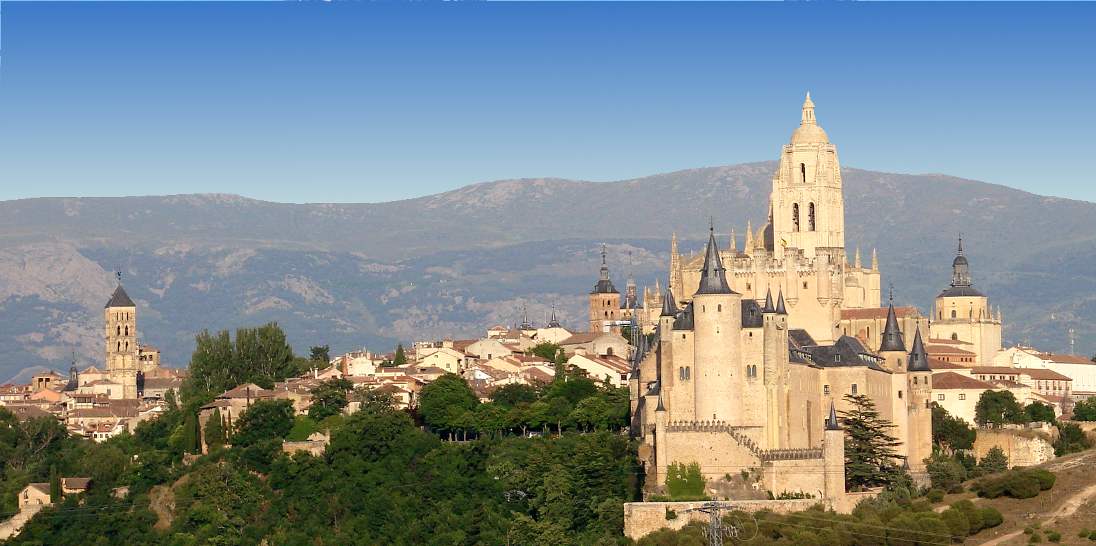About-Spain.net - the alternative guide to Spain
| On this page: | Avila | Segovia | Salamanca | Other cities | Other sites |

Castile & Leon - wide open spaces and big sky country
Castile and León is the largest region in Spain, and covers a large part of the Meseta, the high plateau that includes the large part of northern Spain. The main highway from the north, today the A1 motorway, enters the region close to the small town of Miranda de Ebro before reaching the historic city of Burgos. Here the great routes of Castile divide, taking travellers on in the direction of the region's other great historic cities – Leon, Valladolid and Salamanca, Segovia, or to the Spanish capital Madrid.
A thousand years ago, when Mediaeval Europe was taking shape following the turmoil of the "Dark Ages", the kingdoms of Castile and León were the springboard from which the Christian reconquest of Spain spread southwards. The two kingdoms united In the thirteenth century, and from then on formed the nexus of what was to become the Kingdom of Spain.

Today, travellers venturing through Castilla y León, en route to southern Spain or Portugal may get the impression that this is an endless area of vast open horizons or arid hills and valleys, a place to view at speed from the long half-empty motorways that cross it: it

Traffic
jam on a small road in Castile
Climate has always been one of the greatest factors determining how people live and where they live; and Castile and León is no exception to the rule. The harsh climate led historically to people congregating in places along river valleys, where small towns and cities grew up – leaving much of the rest of the area open, unprotected and very sparsely inhabited. The historic cities thrived and were prosperous, the rural areas were mired in poverty. And where towns and cities grew up, or rich men and grandees established their territory, they did so behind strong defences, to protect themselves from invaders or pillagers - be they Visigoths, Moors, or Christians. And the fortified cities and castles of northen central spain gave the area its name - the land of castles, or Castile.
Places to visit
Castile and León is a treasure trove of historic sites and impressive landscapes. With its hundreds of mediaeval castles and fortresses - witnesses to the area's turbulent past - its tiny villages, its open spaces, changing landscapes, and its historic cities and great cathedrals, this is an area for anyone wanting to explore the real Spain.Most interesting cities:
Avila :

 This
fully-walled mediaeval city is a UNESCO world heritage site, and a
unique experience. Visitors can walk along the ramparts, but not
completely round the city. Avila also has a fine early gothic
cathedral, one of the oldest in Spain, with beautiful and unusual
Renaissance cloisters. The most impressive view of the city ramparts
(as in the photo above) is
had from a viewpoint at Los Cuatro Postes on the hillside opposite, ten
minutes' walk from the Puerta del Puente, at the lower end of the
town. Avila is an hour and a half from Madrid by bus or by
train.
This
fully-walled mediaeval city is a UNESCO world heritage site, and a
unique experience. Visitors can walk along the ramparts, but not
completely round the city. Avila also has a fine early gothic
cathedral, one of the oldest in Spain, with beautiful and unusual
Renaissance cloisters. The most impressive view of the city ramparts
(as in the photo above) is
had from a viewpoint at Los Cuatro Postes on the hillside opposite, ten
minutes' walk from the Puerta del Puente, at the lower end of the
town. Avila is an hour and a half from Madrid by bus or by
train.Salamanca :
Seat of the oldest university in Spain, Salamanca has a fine historic centre, which is listed as a UNESCO world heritage site. The most interesting monuments are the great cathedral - or rather cathedrals. The great "new" cathedral is a fine late gothic-baroque edifice; but fortunately, when local notables decided to rebuild the city's cathedral in the 16th century, they took the unusual decision to build the new beside the old, rather than demolish the old cathedral to make place for the new one. The old cathedral, in romanesque / early gothic style, is notable for its fabulous 15th century gilt altarpiece by the Italian artist Dello Delli. (► More cathedrals)Salamanca's Plaza Mayor is one of the finest in Spain. Around it, the narrow streets of the old city of Salamanca offer a rich collection of historic buildings, including university buildings and ornate private dwellings. Among the most interesting is the Casa de las Conchas, an early 16th century town house whose facade is decorated with over 300 carved scallop shells – the symbol carried by pilgrims on the route to Santiago de Compostella.
Segovia:
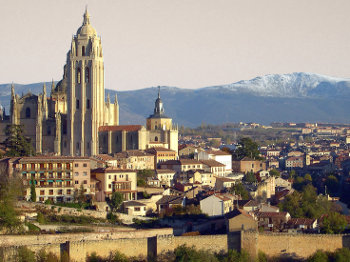
Segovia, city walls, cathedral and Sierra Guadarrama .
Other interesting cities
Burgos :
the historic capital of Castile is a modern city with an ancient centre, and has many historic sites. The most emblematic of these is perhaps the Arco de Santa Maria (picture above right), one of the finest mediaeval city gates in Europe. Close by is the cathedral of Santa Maria, a thirteenth century gothic cathedral and UNESCO world heritage site: Burgos cathedral is the third largest cathedral in Spain, and is very much a European cathedral, its architects and builders having come from France and Germany. The third great historic monument of Burgos is the 15th century Cartuja de Miraflores, a former Carthusian monastery and royal residence. The abbey is one of the finest late gothic buildings in Spain, and contains an ornate altarpiece by the sculptor Gil de Siloé.Finally, Burgos also has a very interesting modern museum, the ethnological Museum of Human Evolution, which was opened in 2010 as an extension of the Atapuerca archeological site ten miles away. The Atapuerca site itself is another UNESCO world heritage site, and is the site of the earliest known traces of human life in western Europe.
León :
Historic León is best known for its fine high gothic cathedral and for the austere and older basilica of San Isidoro. In the crypt of San Isidoro can be seen the Royal Pantheon, a jewel of romanesque art. The pantheon contains the tombs of the kings and queens of León of from the 10th to the 12th century, and its vaults are decorated with the finest collection of 12th century romanesque frescoes in Spain. The museum contains a remarkable collection of early mediaeval artefacts.For more modern artefacts, visit the Museo de Arte Contemporáneo de Castilla y León, opened in 2010, and described as one of Europe's major contemporary art museums.
Valladolid :
This is the largest city in Castile & Leon, and can be reached by high speed train from Madrid. The old town contains an interesting collection of mediaeval and renaissance buildings: the cathedral was started in the seventeenth century, but never completed. The most interesting historic edifice is the church of San Pablo, with a unique sculpted west facade.Zamora :
The small city of Zamora is home to one of the most interesting and unusual romanesque cathedrals in Spain. In an enclave surrounded by mediaeval walls and gates, the cathedral is in particular remarkable for its 12th century dome.The south door of the cathedral has a fine romanesque sculpted typmanum.Other sites
Castles

Castle
of la Mota at Medina del Campo
Apart from the Alcazar at Segovia, the region's most famous castles are the massive Castello la Mota at Medina del Campo, and the extensive castle at Peñafiel, one of the biggest mediaeval castles in Europe. Both of these lie well away from major tourist routes, though Medina del Campo is beside the main A6 motorway to northwest Spain, and Peñafiel is not too far southeast of Valladolid.
there are hundreds more castles in Castilla y Leon; some other interresting castles can be found at Arevalo (between Avila and Medina del Campo - the castle has been beautifully renovated, and houses a small museum), Valencia de Don Juan (a very impressive fortress south of Leon, close to the A66 route) , the small but well preserved Castillo de Olmillos de Sasamón (west of Burgos on the road to Leon), or the privately-owned but visitable castle in the attractive small town of Ampudia, west of Palencia, which featured in the 1964 Hollywood film El Cid. Just 15 km west of Ampudia is yet another impressive castle,at Montalegre de Campos : if one were to select a site most emblematic of Castilla y Leon, it might be this castle, standing on a spur of land at the edge of a sleepy village, and looking out over the plains all around.
On the other hand it might also be the massive tenth to fourteenth century castle at Gormaz, near Soria, the largest fortress in Europe, built originally by the Moors to defend the caliphate of Cordoba.
Well off the main roads, and lying 80 km NNW of Segovia, the small town of Coca has one of the finest and best preserved Mudejar castles in Spain - a 15th century edifice built largely of brick. Thirty kilometres northeast of Coca is the small town of Cuéllar, which has not just a fine castle, but also a good length of surviving city walls.
There are also a number of ruined castles, on hilltops or on plains, that can be freely accessed - but sometimes can only be reached via tracks or hiking trails.
For more Spanish castles,see Castles in Spain
Some other sites and places to visit in Castilla y Leon:
Monuments: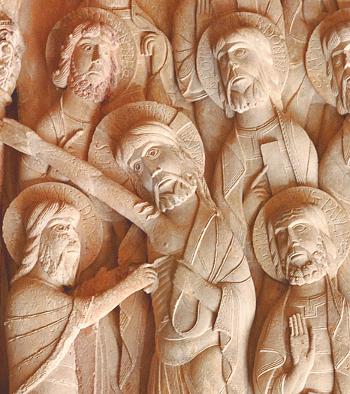
Doubting Thomas - detail from a 12th century bas relief
at the monastery of Santo Domingo de Silos .
- Monastery of Santo Domingo de Silos - 50 km south east of Burgos : perhaps the best romanesque cloister in the whole of Europe: two levels of cloister, with richly decorated sculpted capitals from the 11th and 12th centuries. Santo Domingo is still a working monastery
- Cuevas de Valporquero : north of León - a magnificent journey underground into a world of stalacmites and stalactites.
- Roman mines of Las Medulas : near Ponferrada, northwest León province, near the border with Galicia. The most significant Roman mining works visible today. A UNESCO world heritage site. For the Romans, this was one of the most important sites in Spain - a source of the Roman Empire's mineral wealth.
Hiking in Castile and Leon.
The region is traversed by two of the main pilgrimage routes towards Santiago de Compostella: the main inland route from France (GR 65) crosses the northern half of the region, via Burgos, Carrion de los Condes, León and Astorga. The Via de la Plata (GR 100) comes up from Seville, in Andalucia, and crosses the west of the region, through Salamanca Zamora, and Astorga, and on to Oviedo.
Another hiking trail, the Senda del Duero (GR 14), follows the Duero valley from near Aranda de Duero as far as Barca d'Alba on the Portuguese border - and thence on through the Northern region of Portugal.
Mountains
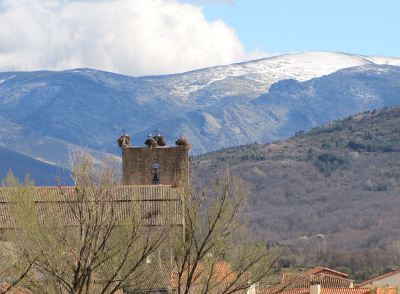
The Sierra de Gredos in spring - near Barcos de Avila .
The Picos de Europa, and the Cantabrian range, mark the northern border of Castile and Leon; though mostly in Asturias and Cantabria, the southern slopes of these high ranges are in Castile and Leon. Unlike the northern slopes of these ranges, watered by the rains off the Atlantic, the southern slopes are generally dry and barren.
Other
pages of interest :
- Andalucia - Extremadura - Valencia
- Undiscovered
Spain - The coasts
of Spain - Travel
in Spain
- Food
and eating in Spain - Driving in Spain
- Spanish
motorway map
Castile and León
hotel finder :
hotel finder :
 For
the independent traveller, a choice of hotels and hostales in the main
cities of Castile and León and their surrounding
areas.
For
the independent traveller, a choice of hotels and hostales in the main
cities of Castile and León and their surrounding
areas.► Select city & star rating
for a broad choice of hotels and the best discounted online booking rates available.
| City | Budget hotels |
Quality hotels |
| Avila | 1-star | 3-star |
| 2-star | 4-star | |
| Burgos | 1-star | 3-star |
| 2-star | 4-star | |
| Leon | 1-star | 3-star |
| 2-star | 4-star | |
| Segovia | 1-star | 3-star |
| 2-star | 4-star | |
| Salamanca | 1-star | 3-star |
| 2-star | 4-star |
These links will take you to Booking.com, Europe's leading online hotel booking portal
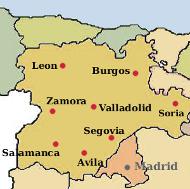
Click for larger map of Spain
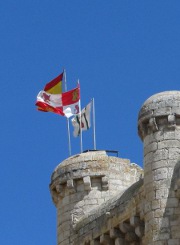
The flag of Castilla y León flying on a small castle
Getting
to Castilla y León :
By car via the southwest corner of France, and San Sebastian. Alternativly, take the ferry from Plymouth or Portsmouth to Santander.
Fly to Castile: There are plenty of scheduled flights to Madrid.
Burgos and Valladolid are on the main train line from France, via Bordeaux, to Madrid and Portugal. Burgos, Valladolid and León can be reached by AVE high-speed trains from Madrid.
By car via the southwest corner of France, and San Sebastian. Alternativly, take the ferry from Plymouth or Portsmouth to Santander.
Fly to Castile: There are plenty of scheduled flights to Madrid.
Burgos and Valladolid are on the main train line from France, via Bordeaux, to Madrid and Portugal. Burgos, Valladolid and León can be reached by AVE high-speed trains from Madrid.
Neighbouring
regions :
About-Spain.net has pages on neighbouring regions:
About-Spain.net has pages on neighbouring regions:

Mediaeval gateway to Burgos
| ►► Spain - a thematic guide: |
| Spain - the country Essential information about Spain. |
| Driving
in Spain Getting round Spain by car - roads and driving tips |
| Spain by train A guide to taking the train in Spain |
| Tourism
in Spain
Where to go and what to see |
| The coasts of spain |
| Top attractions in Spain |
| Andalucia |
| Eastern Andalucia |
| Western Andalucia |
| Asturias |
| Castile y Leon |
| Castile La Mancha |
| Extremadura |
| Navarre |
| Valencia |
| Undiscovered Spain |
| Map of the Spanish regions |
| Accommodation
in Spain Where to stay, and the different options available |
| The
Spanish
way of life Spain is different; all you need to know about Spanish habits, including |
| Spanish food and eating |

Austere, isolated, defensive. The castle at Montalegre de Campos .
Photos and text copyright About-Spain.net
Except photo top of page by Segonvia

